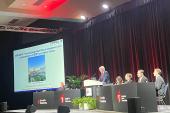ACC Updates Pathway for Hospitalized HF Patients
One big change is an emphasis on getting patients on SGLT2 inhibitors during the initial admission whenever possible.

The American College of Cardiology has updated its expert consensus decision pathway for patients hospitalized with heart failure (HF), bringing it in line with recommendations in the latest US guidelines, published in 2022.
The general treatment concept remains the same as in the earlier pathway from 2019: individualize therapy according to the clinical trajectory of the patient. But there is now an emphasis on getting patients with HF and reduced ejection fraction (HFrEF), whenever possible, on all four pillars of guideline-directed medical therapy (GDMT), a list that includes renin-angiotensin-aldosterone system (RAAS) inhibitors, beta-blockers, mineralocorticoid receptor antagonists (MRAs), and sodium-glucose cotransporter 2 (SGLT2) inhibitors.
“The idea is to get the patients on all the medications that we think they should be on. It starts very early,” Steven Hollenberg, MD (Emory University, Atlanta, GA), chair of the writing committee, told TCTMD, adding that “establishment and maintenance of that therapy is ongoing.”
The pathway summary graphic in the document—which tracks the focus of care starting at admission and continuing through the transition to oral therapies, discharge, the first follow-up visit, and the transition to chronic management—has been updated to include a note that SGLT2 inhibitors, now backed by the results of several trials, can be initiated at any point during the hospitalization either before or in conjunction with the other therapies as long as there are no contraindications.
SGLT2 inhibition “doesn't really have an effect on blood pressure,” Hollenberg said. “You have to think a little bit about side effects, a little bit about the kidneys, but basically you can start that at any time. You can start it early, you can start it late, and it's relatively easy to start one dose, set it, and forget it.”
In discussing the broader concept of the decision pathway, he noted that most of the data on treatment of patients with HF comes from outpatient studies. “The initial document [from 2019] was designed to work around that and try to give clinicians a sense of how to apply those outpatient guidelines to a patient who was an inpatient admitted with heart failure,” he said.
This focused update, published online last week in the Journal of the American College of Cardiology, continues that effort. It also harmonizes the pathway with the full US guidelines as well as expert consensus decision pathways on the optimization of therapy in patients with chronic HFrEF and chronic HF with preserved ejection fraction (HFpEF), both released over the last year-and-a-half.
Changes to the Pathway
The areas of the document that are new or modified revolve around use of SGLT2 inhibitors, the initial triage of HF for admission, decongestion with diuretics and other therapies, clinical trajectories, optimization of neurohormonal modulators during admission for patients with HFrEF, transitions of care, and the role of palliative care during hospitalization.
For the initial triage, Hollenberg and his colleagues added consideration of Hospital at Home, spurred by the COVID-19 pandemic, as an option. This “provides healthcare to acutely ill patients in their homes using methods like telehealth, remote monitoring, cardiac rehabilitation and regular in-person visits by nurses or physicians,” they explain.
Several figures with information on initiation and titration of therapy have been changed, with a new figure, combining three from the older document, that provides tips on how to manage patients with various clinical trajectories—ie, improving, stalled despite an initial response to treatment, and worsening or not improving.
In that last group, “you know you need to do something different,” Hollenberg said. “You need to think about another diagnosis. You need to intensify your therapy. You need to maybe do some hemodynamic assessments to try to figure out what's going on. And maybe you need to think about more-intensive therapies, advanced therapies, and such.”
There is also a new algorithm for basing titration strategies on how a patient with HFrEF presents to the hospital, with a focus on those with an improving trajectory. For those with a new HF diagnosis, for instance, physicians should try to initiate all four pillars of GDMT while paying attention to blood pressure, kidney function, heart rate, and cost. When a patient with chronic HF presents on only partial GDMT, efforts should be made to fill in the treatment gaps. And, the authors say, for the patient with chronic class IV HF despite use of GDMT, physicians should proceed with caution.
“You need to be careful about those people because to some extent they've probably already gotten in some trouble with attempts at titration of therapy and you don't want to get in more trouble,” Hollenberg said.
Overall, he added, the algorithm “represents not so much a change in philosophy, but an attempt to give specific guidelines to clinicians on exactly—as much as possible—how to start guideline-directed medical therapy. It's a little hard to do it as a cookbook because patients are all different.”
In terms of transitions of care, the authors updated several pieces of the pathway, including checklists for the education of patients and their families and caregivers, for communication with clinicians providing continuing care, for a follow-up phone call, and for the first postdischarge visit.
There is also a revamped focused discharge handoff form, which Hollenberg explained is “a conceptual document that basically says, ‘What would you want to know about a heart failure patient who had been in the hospital if you were just meeting them, either in an emergency department or when they got to an outpatient office?’”
Discharge summaries are imperfect and “don't always include all of the things that you might want to include,” he noted. The discharge handoff form covers a wide range of information, including general patient data, a description of the type of heart failure and what triggered it, condition at discharge, vital signs, congestion status, comorbidities, what tests need to be performed, prescribed medications, and other details.
“We've done our best to simplify it,” Hollenberg said, acknowledging that filling out the document won’t be easy. “But if filled out, it is useful, and the second time you do it, is a lot easier than the first time.”
For the larger expert consensus decision pathway, he credited his co-authors for all the work that has gone into it. Parts are conceptual, he said, but “the design is to give useful advice to clinicians taking care of these patients. And I hope it does that.”
Todd Neale is the Associate News Editor for TCTMD and a Senior Medical Journalist. He got his start in journalism at …
Read Full BioSources
Hollenberg SM, Stevenson LW, Ahmad T, et al. 2024 ACC expert consensus decision pathway on clinical assessment, management, and trajectory of patients hospitalized with heart failure focused update. J Am Coll Cardiol. 2024;Epub ahead of print.
Disclosures
- Hollenberg reports no relevant conflicts of interest.






Comments